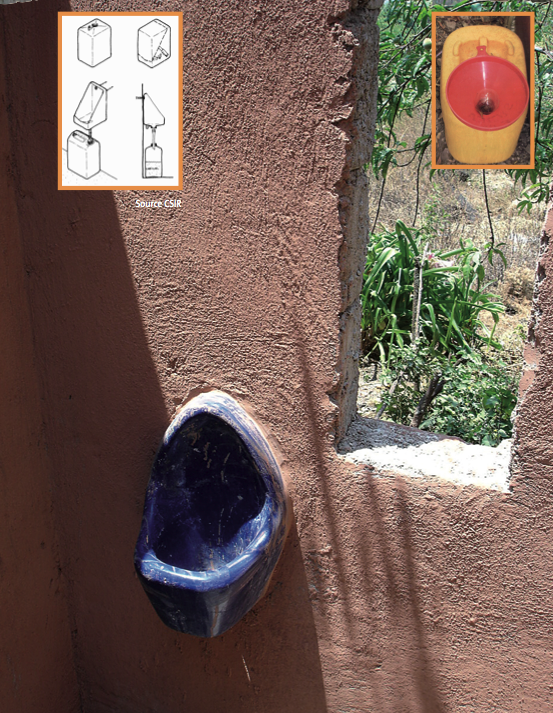Difference between revisions of "Urinal"
| Line 23: | Line 23: | ||
[[Image:Icon_urinal.png|right|95px]] | [[Image:Icon_urinal.png|right|95px]] | ||
| + | [[Image:Waterless_urinal.png|thumb|right|150px|[[Waterless urinal |Waterless urinal]], in Ethiopia (click photo for credits)]] | ||
| + | |||
'''A Urinal is only used for collecting urine. Urinals are generally for men, although Urinals for women have also been developed.''' | '''A Urinal is only used for collecting urine. Urinals are generally for men, although Urinals for women have also been developed.''' | ||
Urinals for women consist of raised foot-steps and a sloped channel or catchment area for conducting the urine to a collection technology. For men, Urinals can either be wall-mounted units that are vertical, or squat slabs that the user squats over. Most Urinals use water for flushing, but waterless Urinals are becoming increasingly popular. As waterless Urinals collect undiluted urine, they generate the lowest volumes. | Urinals for women consist of raised foot-steps and a sloped channel or catchment area for conducting the urine to a collection technology. For men, Urinals can either be wall-mounted units that are vertical, or squat slabs that the user squats over. Most Urinals use water for flushing, but waterless Urinals are becoming increasingly popular. As waterless Urinals collect undiluted urine, they generate the lowest volumes. | ||
| − | |||
| − | |||
Revision as of 01:06, 10 January 2013
 Waterless urinal, in Ethiopia (click photo for credits) A Urinal is only used for collecting urine. Urinals are generally for men, although Urinals for women have also been developed. Urinals for women consist of raised foot-steps and a sloped channel or catchment area for conducting the urine to a collection technology. For men, Urinals can either be wall-mounted units that are vertical, or squat slabs that the user squats over. Most Urinals use water for flushing, but waterless Urinals are becoming increasingly popular. As waterless Urinals collect undiluted urine, they generate the lowest volumes.
ContentsAdequacyThe Urinal can be used with or without water and the plumbing can be developed accordingly. If water is used, it is mainly used for cleaning and limiting odours (where the water acts as a water-seal). Water-based Urinals use 8 to 12 litres of flushwater, whereas low-flush models use less than 4 litres of flushwater. Because the Urinal is exclusively for urine it is important to also provide another toilet to be used for faeces. Waterless Urinals are available in a range of styles and complexities. Some Urinals come equipped with an odour seal that may have a mechanical closure, a membrane, or a sealing liquid. To minimize odours in simple Urinal designs, each Urinal should be equipped with a dedicated pipe that is submerged in the collected urine (or tank) to provide a basic water-seal. Portable waterless Urinals have been developed for use at large festivals, concerts and other gatherings, to improve the on-site sanitation facilities and reduce the point load of wastewater discharged at the site. In this way, a large volume of urine can be collected (and either used or discharged at a more appropriate location or time) and the remaining urine/faeces toilets can be reduced or used more efficiently. Urinals can be used in homes as well as within public facilities. Traditionally urinals are provided adjacent to a toilet. Urinals can prevent fouling of toilets, especially in schools. By putting a small target, or painted fly near the drain, the amount of spraying or splashing can be reduced; this type of user-guidance can help improve the cleanliness of the facility. Urinals are appropriate for every climate. Health Aspects/AcceptanceThe Urinal is a comfortable and easily accepted User Interface. In some cases, the provision of a Urinal is useful to prevent the misuse of dry systems (e.g. UDDT). Urinals, although simple in construction and design, can have a large impact on the well-being of a community. When men have access to a Urinal, they may be encouraged to refrain from urinating in public, which reduces unwanted odours and allows women to feel more comfortable. Men have generally accepted waterless Urinals, as they do not call for any change of behaviour. MaintenanceMaintenance is simple, but should be done frequently. Minerals and salts may build up in pipes and on surfaces where urine is constantly present. To prevent scaling, slightly acidic water and/or hot water can be used to dissolve any minerals that form. All of the surfaces should be cleaned regularly (bowl, slab and steps) to prevent odours and to minimize solids formation. Manuals, videos, and linksThe `Eco-Lily' from Ethiopia is made out of a common liquid container with a used light bulb acting as a floating `odour-lock' to reduce smells. The `Eco-Lily' is a device to be used as urinal both by men and women. SUDEA's experiences have showed that men can use it without any explanation while women often need some information on how to use it because of their biological difference. This Factsheet gives useful information about the installation of as Waterless Urinal.
References
AcknowledgementsThe material on this page was adapted from: Elizabeth Tilley, Lukas Ulrich, Christoph Lüthi, Philippe Reymond and Christian Zurbrügg (2014). Compendium of Sanitation Systems and Technologies, published by Sandec, the Department of Water and Sanitation in Developing Countries of Eawag, the Swiss Federal Institute of Aquatic Science and Technology, Dübendorf, Switzerland. The 2nd edition publication is available in English. French and Spanish are yet to come. |
|||||||||||||||


